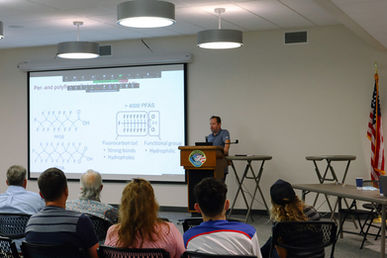



Protecting Brevard from Toxic Chemicals
Don't let PFAS go unnoticed. Fight for Zero is a partner in a research initiative dedicated to collecting data on PFAS chemicals on Florida's space coast. Our primary goal is to provide valuable information to the community and promote actions that protect our health and environment.
Understanding the Presence of PFAS in Our Community
These toxic chemicals are used in firefighting foam, which is extensively used in airports and military bases, and fluoropolymers (a specific class of PFAS) in the aerospace industry.
As a result, many communities near these facilities have been exposed to high levels of contamination, resulting in serious health issues.
PFAS are a family of more than 10,000 man-made chemicals that have been used for almost 70 years in many manufacturing and industrial applications. These chemicals, over time, leak into soil, water, and air.
At Fight for Zero, we believe that it is essential to hold polluters accountable for their role in PFAS pollution and work towards finding alternative solutions.


FIGHT4ZERO.ORG/UFPROJECT


Understanding How Flooding Moves Pollution
Floods can be especially dangerous, carrying hazardous pollutants and chemicals like PFAS into residential neighborhoods and parks.
Coastal communities deal with intense storm surges and inland flooding. During hurricanes and extreme weather events, sediment can be carried and deposited downstream in residential neighborhoods and parks. Flooding carries hazardous pollutants and can transport harmful chemicals like PFAS further inland and contaminate the soil.
These events can increase your risk of exposure to contaminants that harm health, such as heavy metals, pesticides, and PFAS, by spreading with floodwaters.
Flooding also intensifies infrastructure issues, causing "boil" notices, contamination of drinking water sources, and failure of sewage systems, forcing wastewater treatment facilities to discharge material into surrounding water bodies. The risk of exposure is great when industrial or agricultural land is next to residential land. It is vital to assess the risk to communities at the fenceline of polluting facilities and for state agencies to protect them from harm.
At Fight for Zero, we are dedicated to ensuring that all communities have access to clean water and air, and we take a comprehensive approach to flood risk mitigation. This includes identifying areas at high risk of flooding, implementing resilience measures, and promoting sustainable environmental practices to reduce the likelihood of future floods.
Explore sea level rise and coastal flood threats with this interactive map by ClimateCentral.org
Together We Can Achieve Zero Pollution
Following the release of a report by the Department of Defense on the presence of PFAS chemicals in Brevard County's water, we at Fight for Zero knew that we had to act. These chemicals are known to cause cancer and other health problems, and our goal is to ensure that the public is aware of this threat and is demanding action to address it. We are constantly working to educate the public and raise awareness of this issue.
In collaboration with the University of Florida and organizations like ORCA, citizen scientists with Fight for Zero have gathered over 500 data points in Brevard County. This data establishes a baseline and shows how storm flooding can exacerbate the transport of contaminants from polluted sites to the Indian River Lagoon and surrounding communities. The community sampling efforts include measuring PFAS concentrations at key locations across the county where people may come into contact with contaminated soil and water.
Although the project primarily centers on Brevard County, researchers also collected data on PFAS in Jacksonville and other communities across Florida for additional studies.
One of our main focuses is addressing PFAS contamination, which has become a serious concern for our coastal communities. We believe in utilizing the latest scientific research and working collaboratively with national and regional allies to educate the public and fight for meaningful change. Our goal is to ensure that every person can live in a safe and healthy environment.



PFAS Water Test Kit: Peace of Mind for Your Family
Concerned about your water quality? Don’t wait for symptoms of exposure to PFAS. This PFAS water test kit is a fast, easy, and affordable way to check for harmful substances in your drinking water. Get peace of mind with a reliable reading in weeks, plus helpful resources on what to do next.
Unless stated, the information on this website, including images, text, audio, video, and other forms of content is copyrighted and may not be downloaded, reproduced, republished, or otherwise copied without express written permission of Fight For Zero. Images with logos may be shared.



























